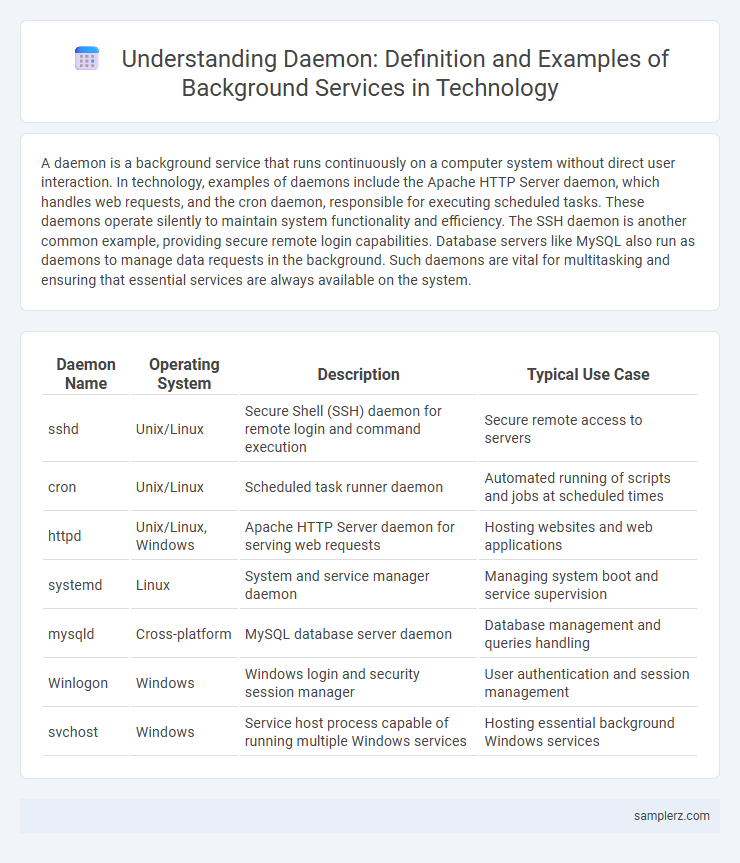A daemon is a background service that runs continuously on a computer system without direct user interaction. In technology, examples of daemons include the Apache HTTP Server daemon, which handles web requests, and the cron daemon, responsible for executing scheduled tasks. These daemons operate silently to maintain system functionality and efficiency. The SSH daemon is another common example, providing secure remote login capabilities. Database servers like MySQL also run as daemons to manage data requests in the background. Such daemons are vital for multitasking and ensuring that essential services are always available on the system.
Table of Comparison
| Daemon Name | Operating System | Description | Typical Use Case |
|---|---|---|---|
| sshd | Unix/Linux | Secure Shell (SSH) daemon for remote login and command execution | Secure remote access to servers |
| cron | Unix/Linux | Scheduled task runner daemon | Automated running of scripts and jobs at scheduled times |
| httpd | Unix/Linux, Windows | Apache HTTP Server daemon for serving web requests | Hosting websites and web applications |
| systemd | Linux | System and service manager daemon | Managing system boot and service supervision |
| mysqld | Cross-platform | MySQL database server daemon | Database management and queries handling |
| Winlogon | Windows | Windows login and security session manager | User authentication and session management |
| svchost | Windows | Service host process capable of running multiple Windows services | Hosting essential background Windows services |
Understanding Daemons: The Backbone of Background Services
Daemons like cron and systemd are essential background services in Unix and Linux systems, managing scheduled tasks and system processes without user intervention. These processes run continuously, enabling efficient resource allocation and system maintenance by handling jobs such as backups, updates, and log monitoring. Understanding daemons reveals their role as fundamental components ensuring seamless operation and automation within modern operating systems.
Key Characteristics of Daemon Processes
Daemon processes operate silently in the background, managing system tasks without direct user interaction, such as the cron daemon scheduling automated jobs at specified intervals. They launch during system startup, run continuously to provide essential services, and terminate only upon system shutdown or manual intervention. Key characteristics include independence from terminal control, ability to run under minimal privileges for security, and efficient resource usage to avoid impacting overall system performance.
Common Examples of Daemons in Operating Systems
Common examples of daemons in operating systems include the cron daemon, which schedules and manages automated tasks, and the sshd daemon, responsible for handling secure remote login sessions. The httpd daemon serves web pages by managing HTTP requests on servers, while the syslogd daemon processes and stores system log messages. These background services run continuously without direct user interaction, ensuring system functionality and resource management.
Web Server Daemons: Handling Requests in the Background
Web server daemons like Apache HTTP Server and Nginx operate as background services that continuously listen for and handle incoming HTTP requests. These daemons manage processes such as request parsing, resource allocation, and response delivery without user intervention, ensuring efficient and uninterrupted web service operations. By running in the background, web server daemons optimize server performance and provide scalability for handling multiple simultaneous connections.
Database Daemons: Ensuring Continuous Data Access
Database daemons like MySQLD and PostgreSQL's postmaster run continuously in the background, managing database connections and queries without user intervention. These background services optimize data retrieval and transaction processing to ensure high availability and reliability of database systems. By maintaining persistent processes, database daemons support seamless data access and improve overall system performance in real-time applications.
Print Spooler Daemon: Managing Print Jobs Efficiently
The Print Spooler Daemon operates silently in the background, managing print jobs by queuing and directing them to printers efficiently. It optimizes workflow by handling multiple print requests simultaneously without user intervention. This background service prevents print job conflicts and ensures timely document output across networked printers.
Cron Daemon: Scheduling Automated Tasks
The Cron daemon is a fundamental background service in Unix-like operating systems that schedules automated tasks by executing scripts or commands at specified times or intervals. It relies on crontab files to define the timing and frequency of jobs, enabling system maintenance, backups, and updates without manual intervention. This daemon enhances system efficiency by ensuring repetitive tasks run precisely and reliably according to predefined schedules.
SSH Daemon: Enabling Secure Remote Connections
SSH Daemon (sshd) operates as a background service that facilitates secure remote access by encrypting communications between client and server, ensuring data integrity and confidentiality. Commonly deployed on Unix-like systems, sshd listens for incoming connection requests on port 22, authenticates users, and manages secure shell sessions. This daemon enables system administrators to manage servers remotely, execute commands, and transfer files securely over potentially insecure networks.
Mail Transfer Daemon: Powering Email Delivery Systems
Mail Transfer Daemon (MTD) operates silently in server environments, managing the transmission of email messages between client devices and mail servers. This background service uses SMTP protocols to route, queue, and deliver emails efficiently, ensuring reliable communication across networks. Its continuous operation handles tasks like message prioritization, error reporting, and spam filtering, making it an indispensable component of modern email infrastructure.
Custom Application Daemons: Creating Your Own Background Services
Custom application daemons run as background services that perform specific tasks without user intervention, improving efficiency and system performance. Developers create these daemons using languages like Python, C++, or Go, implementing continuous monitoring, data processing, or automated maintenance. Common examples include log rotation services, real-time data collectors, and custom notification handlers tailored to unique application requirements.

example of daemon in background service Infographic
 samplerz.com
samplerz.com